Belfast Blitz Plaques
Following the 75th Anniversary of the 1941 German air raids on Northern Ireland, Belfast City Council erected a number of memorial plaques at various locations in the city. The phrasing of the inscriptions on all but three of the plaques refers to “lives lost here” but it is unclear whether it refers literally to fatalities at the location/street, the number of people who lived in the location/street who died, the number of people from the area near the location who died, or a mixture of the circumstances.
 The Commonwealth War Graves Commission (CWGC) website includes a Civilian War Dead section which lists the place of death and the place of residence for fatalities, the information having been collated from the Civil Defence Authority fatality lists and other sources. The anomalies between the figures specified on the Belfast City Council plaques and the CWGC Civilian War Dead List (henceforth CWGC List) will be examined in this article.
The Commonwealth War Graves Commission (CWGC) website includes a Civilian War Dead section which lists the place of death and the place of residence for fatalities, the information having been collated from the Civil Defence Authority fatality lists and other sources. The anomalies between the figures specified on the Belfast City Council plaques and the CWGC Civilian War Dead List (henceforth CWGC List) will be examined in this article.
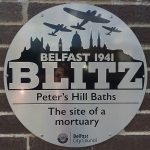 1 Temporary Mortuaries
1 Temporary Mortuaries
The first plaque was erected at St George’s Market, which was used as a temporary mortuary following the air raids and was the centralised location for the identification of bodies. On 21st April and 9th May, funeral corteges left St George’s Market, with unidentified and identified but unclaimed bodies being interred in publicly-owned plots in Belfast City Cemetery and Milltown Cemetery.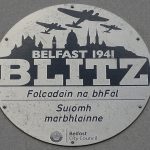
Plaques were also erected to mark the use of the Peter’s Hill Baths and the Falls Road Baths as temporary mortuaries, but no arrangements were made to erect a similar plaque at the temporary mortuary at Erskine’s Felt Works in Whitehouse.
2 Campbell College
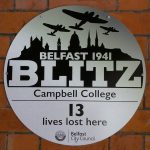 Campbell College was taken over by the military authorities as the 24th (London) General Hospital shortly after the start of the Second World War and was hit on the night of 4th/5th May 1941. The Blitz Victims List compiled by the Northern Ireland War Memorial records that 24 people died at the hospital, including one civilian fatality. Of the 23 army personnel killed, nine are buried in Northern Ireland and the remainder were repatriated to Great Britain for interment. The civilian was Mary Jane Close (58) who was injured at her home in Westbourne Street and died at the hospital and is buried in Dundonald Cemetery.
Campbell College was taken over by the military authorities as the 24th (London) General Hospital shortly after the start of the Second World War and was hit on the night of 4th/5th May 1941. The Blitz Victims List compiled by the Northern Ireland War Memorial records that 24 people died at the hospital, including one civilian fatality. Of the 23 army personnel killed, nine are buried in Northern Ireland and the remainder were repatriated to Great Britain for interment. The civilian was Mary Jane Close (58) who was injured at her home in Westbourne Street and died at the hospital and is buried in Dundonald Cemetery.

3 Pottinger – Ravenscroft Avenue
The CWGC List records Ravenscroft Avenue as the death location for only five people, including four members of the Frizzell family from Number 39 and Thomas Crone Bingham, a sixteen-year-old ARP volunteer from Isoline Street. However, a further sixteen people died in the Ravenscroft Avenue area. Fifteen lives were lost at Avondale Street, including six members of the McCullough family at Number 8. Another sixteen-year-old ARP volunteer, William James Mays from Lichfield Avenue, died at Rosebery Street. Consequently, the German bombing of the Ravencroft Avenue area resulted in the deaths of 21 people but only five died at Ravenscroft Avenue. Ravenscroft Public Elementary School was destroyed, and 47 houses were either destroyed or left uninhabitable.
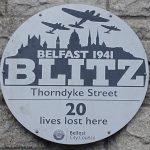 4 Mountpottinger – Thorndyke Street
4 Mountpottinger – Thorndyke Street
On the night of 15th/16th April, a 250kg bomb exploded near the air raid shelter, causing the walls to buckle and the concrete roof fell on the people inside. The CWGC List records that seventeen people died in Thorndyke Street, nine at the air raid shelter. Thirteen of the fatalities were residents of the street, including six members of the Wherry family from Number 16. Four of the Thorndyke Street fatalities resided elsewhere – ARP Warden Joseph Bell (45) of Lord Street, ARP Messenger Phares Hill Welsh (16) of Paxton Road, William Stewart (55) of Lord Street, and William Murray (30) of Cherryville Street. Another resident of Thorndyke Street, Sarah Hughes (62), died at the Royal Victoria Hospital and Andrew McAdams (75) died in nearby Dufferin Street. The bomb that exploded at Thorndyke Street resulted in the deaths of nineteen people.
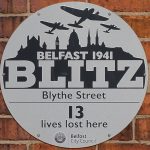 5 Sandy Row – Blythe Street
5 Sandy Row – Blythe Street
The only Blitz Plaque in South Belfast is attached to an outer wall of St Aidan’s Church of Ireland and records that thirteen lives were lost at Blythe Street, which matches the details on the CWGC List. Fourteen people who lived in Blythe Street died as a result of the air raid, including a father and daughter who were injured at Blythe Street, died at the Belfast Union Infirmary, and are buried in Ballynure Cemetery – Rebecca Craig (7) died on 16th April and Robert Craig (36) died two days later. Nine people died at 95 Blythe Street, the home of William and Jane McKee, who lost a son, two married daughters, and five grandchildren. David McKee (26) was an Engineer in the Merchant Navy and Sarah Jane (Sadie) Thompson (21) from 313 Donegall Road, was visiting the family when she died.
6 Yorkgate – Sussex Street and Vere Street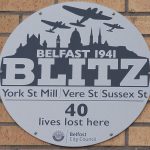
Although the York Street Flax Spinning Mill took a direct hit, no fatalities are recorded as dying at the mill. However, the falling masonry from the mill and other bombs brought death and destruction to the close-packed streets of housing between the mill and Gallaher’s tobacco factory at Earl Street. In 1939, there were 260 residential properties in the area but there were only 128 houses after 1941. In addition, York Street Presbyterian Church on the corner of Earl Street and York Street Non-Subscribing Presbyterian Church were destroyed. The CWGC List records that thirty-four people died in either Sussex Street or Vere Street, with twenty-nine being residents and the other five being from Pilot Street, New Lodge Road, Chatham Street, Artillery Street, or Orchard Street. Mary McSourley (12) of 74 Vere Street died at the Mater Hospital and the Civil Defence Authority’s 9th List (dated 21st April 1941) records Kathleen Malone of 31 Sussex Street as a fatality but she is not recorded on the CWGC list or on the NIWM Blitz Victims List. Lance Corporal John Thomas Park and Corporal David Cooper Simpson from 507th Field Company, Royal Engineers, died at the junction of Henry Street and North Queen Street during the May air raids. The death toll for the area was 38 and not 40 as recorded on the plaque.
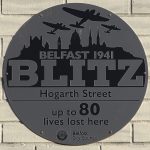 7 Tiger’s Bay – Hogarth Street
7 Tiger’s Bay – Hogarth Street
Unlike other locations where the Belfast City Council plaques specify exact numbers, the plaque at Hogarth Street records “up to 80 lives lost here”. The CWGC List records that 69 civilians died at Hogarth Street and nine died at Edlingham Street, including eight people from other streets. A memorial at Hogarth Street, since removed after being vandalised, recorded the names of 117 fatalities from the Tiger’s Bay area. The CWGC List records that 71 residents of Hogarth Street and Edlingham Street died, with six-year-old Jean Spratt dying of injuries at Belfast City Hospital. Six members of the Wilson family died at 56 Edlingham Street and five people living at 65 Hogarth Street died, including two women from Glasgow. Hugh Baxter McNeill had died on 3rd March 1941, aged 49, and his widow Annie Lorna McNeill (nee Dornan) died on the night of 15th/16th April at the age of 46, along with her children, Hetty (23) and Hugh Baxter McNeill (19). Also at the house were her mother and sister – Harriett Dornan (69) and Cissy (30) – whose home address was in Glasgow. It is possible that William John Dornan sent his family back to Belfast as it was deemed to be safer than Glasgow.
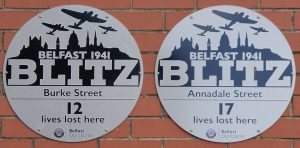
8 New Lodge – Sheridan Street
Two plaques relating to lives lost at two streets which no longer exist were placed at Sheridan Street. The CWGC List records that eleven civilians died at Burke Street, with the twelfth fatality being Stoker 1st Class Henry Brown (51) who was serving on HMS Caroline and died at 18 Burke Street with his mother, his wife, and his daughter – Mary Jane (89), Georgina (50), and Georgina (18). Thomas Mason (33), who was injured at his home in Burke Street and died at the Mater Hospital, is not included on the plaque. The CWGC List records that 18 people who lived in Annadale Street died at their homes, including Ernest William Riecken (65), the only German-born fatality of the air raids, and his wife, Mary Louisa (66) from Number 6.
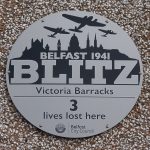
9 New Lodge – Victoria Barracks
The only Blitz plaque that relates exclusively to military fatalities was placed on the gable wall of the terrace of houses called Victoria Barracks on Carlisle Parade. These houses were built in the 1930s as married quarters for the Victoria Barracks and the first house in the terrace was destroyed during the air raid on the night of 15th/16th April and was never replaced. The NIWM Blitz Victims list records that five men from 9th Battalion East Surrey Regiment died at Victoria Barracks. Lieutenant-Colonel Richard Douglas Sutcliffe (50), Second Lieutenant Edward William Cobble (40), and Corporal John William Oliver Mason (29) died on 16th April. Private Denis Patrick James Cuffe (20), and Private Albert Joseph Skinner (20) died on 5th May. Second Lieutenant Cobble, who died whilst being transferred to Musgrave Park Hospital, is the only one of the five fatalities to be buried in Belfast, the bodies of the other four men being repatriated to Great Britain for burial.
 10 Donegall Street – St Patrick’s Church
10 Donegall Street – St Patrick’s Church
This is the only Belfast City Council Blitz plaque that had been placed inside a church in Belfast and records “130 lives lost here”. This is not true as there were no fatalities recorded for Donegall Street and St Patrick’s Church was not one of the churches to be badly damaged or destroyed in the air raids. The specified fatality figure could refer to the number of parishioners of the church who died. Alternatively, it could refer to the number of fatalities from the parish area who died, which would include people who were not Roman Catholics.
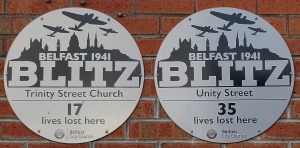 11 Carrick Hill – Unity Street and Trinity Street
11 Carrick Hill – Unity Street and Trinity Street
Two Blitz plaques have been erected on the outer wall of the Carrick Hill Community Centre, which was built on the site of the former Trinity Street Reformed (Covenanting) Presbyterian Church. There were no military fatalities recorded for the Carrick Hill area.
The Unity Street area was devastated when a parachute mine struck the spire of Holy Trinity Church of Ireland, which was located on Unity Street and faced down Trinity Street. The CWGC List records that 34 people died at Unity Street, with another person dying at Wall Street, which was immediately behind the church. The CWGC List records that 28 residents of the street died, with John McAnespie (19) dying of injuries at the Mater Hospital. As many of the houses on Unity Street and Wall Street were subsequently demolished and Holy Trinity Church was not rebuilt, the council built the Stanhope Street Playground on bomb site in 1954.
The fatality figure recorded for “Trinity Street Church” does not stand up to scrutiny as the only person recorded as dying at Trinity Street was Kathleen Duff (16) from Hanover Street who was a Typist at ARP Post 396 and was killed by falling masonry. Six other volunteers at ARP Post 396 died at Unity Street. The only resident of Trinity Street recorded as a fatality was Katherine Muldoon (32) from Number 20 who died in Unity Street and is buried in the graveyard at St Joseph’s Church, Hannahstown.
In an oral account, an ARP Warden refers to the spire of “Trinity Street Church” being hit by a parachute mine but Trinity Street Reformed Presbyterian Church did not have a spire – it was Holy Trinity Church of Ireland that was hit. In effect, the “Trinity Street Church” fatality figure relates to people who died in Unity Street and demonstrates the danger of relying on oral accounts without cross-checking against historic documents and sources.
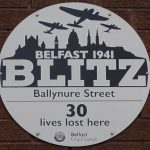
12 The Bone – Ballynure Street
The CWGC List and the NIWM List both record that 29 people died at Ballynure Street, with 26 of the fatalities being residents of the street, and there is no record of any military fatalities. Eleven people died at 4 Ballynure Street, including three members of the Thompson family from 3 Lee Street. Jeremiah and Lavinia Clarke (both 51) and six children ranging in age from 10 to 26 died along with their married daughter, Unice Thompson (19), their son-in-law, John Thompson (21), and their granddaughter, Joan Thompson (2). Only four of the eleven fatalities were identified, with the deaths of the others being presumed at a Coroner’s Enquiry on 14th June 1941. John Thompson is buried in Belfast City Cemetery and Lavinia Clarke is buried in Carnmoney Cemetery. William Clarke (15) and Cecil Clarke (12) were buried in marked coffins in the Blitz Ground at Belfast City Cemetery on 21st April 1941. Robert Clarke (26) was involved in war work at the Short & Harland aircraft factory. In total, 34 people living in the “Bally” streets in this part of Belfast died during the air raids.
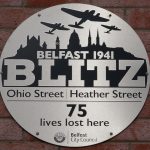
13 Woodvale – Ohio Street and Heather Street
Two identical plaques were erected one at the Welcome Evangelical Church on Heather Street and one at the junction of Ohio Street and Disraeli Street. The CWGC List records that 40 people died at Heather Street, with 37 of the fatalities being residents and the two being from nearby Disraeli Street and Montreal Street. ARP Warden James Henry Robinson (29) from Donaldson Crescent off Twaddell Avenue. The CWGC List records that 25 people died at Ohio, with 22 of the fatalities being residents of the street – two of the fatalities lived in nearby Columbia Street and one lived in Glencairn Crescent off the Ballygomartin Road. The CWGC List records that 72 people died at Heather Street, Ohio Street, and the streets with which they intersect, and that 73 residents of the same area died, three of the latter dying of injuries at hospital.
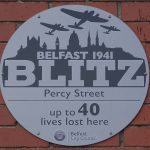
14 Shankill – Percy Street
The Blitz Plaque erected for Percy Street is another which records an approximate fatalities figure. The CWGC List records that 37 people died at Percy Street, ten of whom were not residents of the street. The CWGC List records that 29 residents of Percy Street died in the air raids, with Frederick Owens (41) dying of injuries at the Royal Victoria Hospital. One resident of Percy Street died in the first German air raid on the night of 7th/8th April. Archibald McDonald (22) from 80 Percy Street was a volunteer with the Auxiliary Fire Service and he died fighting the fire at the McCue Dick Timber Yard on Duncrue Street and is buried in Dundonald Cemetery. Four people injured at Percy Street died at the Royal Victoria Hospital, including Thomas Harvey (38) of 12 Tyne Street who died on 8th May 1941 and was buried in Belfast City Cemetery two days later. Ten people died at the Percy Street Air Raid Shelter, including two Able Seaman of the Royal Navy. George James Henry Saunders (21) from Brighton in Sussex was a crewman on HMS Skate which was moored in Belfast Harbour and is buried in a military plot at Belfast City Cemetery. Samuel Corry (26) of Joseph Street in Belfast was on home leave from HMS Quebec and died with his wife, Martha Mary (27) and their ten-month old daughter, Elizabeth. They are buried in a family plot in Belfast City Cemetery.
Conclusion
The fatality figures recorded on the BCC Blitz Plaques rarely tie in with the fatalities recorded by CWGC and NIWM but, as no names are available relating the BCC plaques, it is not possible to reconcile the figures. When I was in contact with BCC about the plaques may years ago, I was told that the council had just been given the figures. The person whose role covered the erection of the plaques moved to a new role and contact with Belfast City Council lapsed. Several plaques (e.g. Antrim Road and Greencastle) were not, as far as I am aware, ever erected. “With hindsight, it would have been better if the plaque figures had represented a combination of fatalities at each location and fatalities who lived at each location. It would also have been better if all the plaques had used “up to nn lives lost” rather than specifying an exact figure. A Freedom of Information Request has been lodged with Belfast City Council seeking details of how the figures quoted on the plaques were determined.
Author: Nigel Henderson, Researcher, History Hub Ulster
 Whilst researching Arthur Moore Cinnamond, a victim of the 1941 German air raids, I came across an obituary in the Belfast Telegraph that recorded that he was a member of Cliftonville Golf Club. Hugh Daly from Cliftonville Golf Club informed me that Arthur had been a member of the club’s council in 1911 and was club Captain in 1925. At the Annual Meeting of the club in March 1919, Arthur Cinnamond intimated his intention to provide a special victory prize to commemorate club members who had served in the Great War.
Whilst researching Arthur Moore Cinnamond, a victim of the 1941 German air raids, I came across an obituary in the Belfast Telegraph that recorded that he was a member of Cliftonville Golf Club. Hugh Daly from Cliftonville Golf Club informed me that Arthur had been a member of the club’s council in 1911 and was club Captain in 1925. At the Annual Meeting of the club in March 1919, Arthur Cinnamond intimated his intention to provide a special victory prize to commemorate club members who had served in the Great War. William Henry Calvert was born on 7th June 1892 at Oldpark Road to William Henry Calvert, a draper, and Margaret Calvert (nee McKay). The family was living at Cliftonville Street in 1911 when William junior was an apprentice jeweller with Gibson and Company of Donegall Place and Castle Place. William Henry Calvert senior was a member of Cliftonville Golf Club Council in 1911 and served on the committee for 18 years.
William Henry Calvert was born on 7th June 1892 at Oldpark Road to William Henry Calvert, a draper, and Margaret Calvert (nee McKay). The family was living at Cliftonville Street in 1911 when William junior was an apprentice jeweller with Gibson and Company of Donegall Place and Castle Place. William Henry Calvert senior was a member of Cliftonville Golf Club Council in 1911 and served on the committee for 18 years. John Dobson was born on 21st December 1889 at Connor in County Antrim to William
John Dobson was born on 21st December 1889 at Connor in County Antrim to William Edwin Samuel Frizelle was born on 26th January 1894 at Ballysaggart near Dungannon to
Edwin Samuel Frizelle was born on 26th January 1894 at Ballysaggart near Dungannon to Frederick William Girvan was born on 23rd May 1893 at Kilbride near Doagh to Robert
Frederick William Girvan was born on 23rd May 1893 at Kilbride near Doagh to Robert Arthur Moore Cinnamond was born on 8th October 1872 at University Street to Arthur Cinnamond, a wine merchant, and Eliza Cinnamond (nee Barber). He was educated at Royal Belfast Academical Institution, Queen’s College in Belfast, and Christ Church in Oxford. After completing his education, Arthur joined the family firm and he married Harriett Mary Molyneux Rogers of Princethorpe, Cliftonville Road, on 22nd November 1898 at St Patrick’s Roman Catholic Church, Donegall Street. In 1901, they were living at Glenisheen on Cliftonville Road and Arthur was a director in Cinnamond Moore Limited (Distillers and Wholesale Wine and Spirit Merchants) of Church Lane. In 1911, Arthur was an auctioneer and valuer, and he became the sole proprietor of Clarke Sons (Auctioneers) of Rosemary Street in 1913. He joined Civic Masonic Lodge No 425 on 13th December 1916 and remained as a member until his death. Harriet Cinnamond died at their Glenisheen home on 3rd October 1938, aged 68.
Arthur Moore Cinnamond was born on 8th October 1872 at University Street to Arthur Cinnamond, a wine merchant, and Eliza Cinnamond (nee Barber). He was educated at Royal Belfast Academical Institution, Queen’s College in Belfast, and Christ Church in Oxford. After completing his education, Arthur joined the family firm and he married Harriett Mary Molyneux Rogers of Princethorpe, Cliftonville Road, on 22nd November 1898 at St Patrick’s Roman Catholic Church, Donegall Street. In 1901, they were living at Glenisheen on Cliftonville Road and Arthur was a director in Cinnamond Moore Limited (Distillers and Wholesale Wine and Spirit Merchants) of Church Lane. In 1911, Arthur was an auctioneer and valuer, and he became the sole proprietor of Clarke Sons (Auctioneers) of Rosemary Street in 1913. He joined Civic Masonic Lodge No 425 on 13th December 1916 and remained as a member until his death. Harriet Cinnamond died at their Glenisheen home on 3rd October 1938, aged 68.
 Lance Corporal Joseph Thompson Larkin (Service Number PLY/X 104620) was serving with 48 Royal Marine Commando when he died on Active Service in France on 6th June 1944, aged 22, and is buried in the Southampton (Hollybrook) Cemetery in Hampshire. Joseph Thompson Larkin was born on 21st December 1921 to Joseph Larkin, a holder-up, and Matilda Larkin (nee Mullan). Matilda Larkin of Lisavon Street died on 11st August 1932, aged 33, and Joseph Larken senior married Maud Winters on 24th July 1937. Joseph and Maud Larkin were living at Sandbrook Park in 1944.
Lance Corporal Joseph Thompson Larkin (Service Number PLY/X 104620) was serving with 48 Royal Marine Commando when he died on Active Service in France on 6th June 1944, aged 22, and is buried in the Southampton (Hollybrook) Cemetery in Hampshire. Joseph Thompson Larkin was born on 21st December 1921 to Joseph Larkin, a holder-up, and Matilda Larkin (nee Mullan). Matilda Larkin of Lisavon Street died on 11st August 1932, aged 33, and Joseph Larken senior married Maud Winters on 24th July 1937. Joseph and Maud Larkin were living at Sandbrook Park in 1944. Private Michael John McGee DCM (Army Number 14216814) was serving with 7th Battalion Parachute Regiment (Army Air Corps) when he died of wounds on 6th June 1944, aged 21, and is buried in Benouville Churchyard. The London Gazette (Supplement: 36994) dated 20th March 1945 reported that Private McGee had been awarded the Distinguished Conduct Medal. As the DCM award was for the same act of gallantry for which Private McGee had been Mentioned in Despatches (London Gazette, 2nd January 1945), the MID award was cancelled. The DCM citation read,
Private Michael John McGee DCM (Army Number 14216814) was serving with 7th Battalion Parachute Regiment (Army Air Corps) when he died of wounds on 6th June 1944, aged 21, and is buried in Benouville Churchyard. The London Gazette (Supplement: 36994) dated 20th March 1945 reported that Private McGee had been awarded the Distinguished Conduct Medal. As the DCM award was for the same act of gallantry for which Private McGee had been Mentioned in Despatches (London Gazette, 2nd January 1945), the MID award was cancelled. The DCM citation read, Sergeant Edward Eli Reynolds (Army Number 3907378) was serving with 2nd Battalion South Wales Borderers when he was killed in action at the age of 33 and is buried in Bayeux War Cemetery. Edward Eli Reynolds was born in Monmouthshire on 1st October 1911 to Edward Eli Reynolds and Elizabeth Ann Reynolds. His mother died in 1912 and his father married Anne Jane Peebles in late 1914. His father was killed in action at Gallipoli on 9th August 1915 whilst serving with 4th Battalion South Wales Borderers. Edward married Elizabeth Ross on 30th October 1937 at Ebrington Presbyterian Church. Edward enlisted in his father’s regiment and Army Order 247 of 1939 reported that Private Reynolds had been awarded the General Service Medal with “Palestine” clasp. Elizabeth Reynolds was living at Waterside in Londonderry when her husband died.
Sergeant Edward Eli Reynolds (Army Number 3907378) was serving with 2nd Battalion South Wales Borderers when he was killed in action at the age of 33 and is buried in Bayeux War Cemetery. Edward Eli Reynolds was born in Monmouthshire on 1st October 1911 to Edward Eli Reynolds and Elizabeth Ann Reynolds. His mother died in 1912 and his father married Anne Jane Peebles in late 1914. His father was killed in action at Gallipoli on 9th August 1915 whilst serving with 4th Battalion South Wales Borderers. Edward married Elizabeth Ross on 30th October 1937 at Ebrington Presbyterian Church. Edward enlisted in his father’s regiment and Army Order 247 of 1939 reported that Private Reynolds had been awarded the General Service Medal with “Palestine” clasp. Elizabeth Reynolds was living at Waterside in Londonderry when her husband died. Private William John Rowe (Army Number 7011445) was serving with 5/7th Battalion Gordon Highlanders when he was reported as “Missing” on 6th June 1944. The War Office Casualty List No. 1543 (5th September 1944) reported that he had been Killed in Action on that date. Private Rowe was 29 years old when he died and is buried in Bayeux War Cemetery. William Rowe was born on 21st March 1915 at Lisnaskea to Thomas Rowe and Isabella Rowe (nee Thompson), his second forename being registered as JOSEPH. His father had accidentally drowned at Clarendon Dock in Belfast on 18th January 1915, aged 40, whilst serving with 11th Battalion Royal Inniskilling Fusiliers (Regimental Number 17258). Thomas Rowe is buried in the Roll of Honour Ground in Belfast City Cemetery and commemorated on the Screen Wall.
Private William John Rowe (Army Number 7011445) was serving with 5/7th Battalion Gordon Highlanders when he was reported as “Missing” on 6th June 1944. The War Office Casualty List No. 1543 (5th September 1944) reported that he had been Killed in Action on that date. Private Rowe was 29 years old when he died and is buried in Bayeux War Cemetery. William Rowe was born on 21st March 1915 at Lisnaskea to Thomas Rowe and Isabella Rowe (nee Thompson), his second forename being registered as JOSEPH. His father had accidentally drowned at Clarendon Dock in Belfast on 18th January 1915, aged 40, whilst serving with 11th Battalion Royal Inniskilling Fusiliers (Regimental Number 17258). Thomas Rowe is buried in the Roll of Honour Ground in Belfast City Cemetery and commemorated on the Screen Wall. Sergeant James Young (Army Number 6977467) was serving with 9th Battalion Parachute Regiment (Army Air Corps) when he was reported as “Missing” on 6th June 1944. In September 1944, the War Office confirmed that he had been Killed in Action on that date. He was 28 years old and is buried in Ranville War Cemetery. James Young was a son of John Joseph Young and Mary Elizabeth Young of Omagh and he had enlisted with Royal Inniskilling Fusiliers.
Sergeant James Young (Army Number 6977467) was serving with 9th Battalion Parachute Regiment (Army Air Corps) when he was reported as “Missing” on 6th June 1944. In September 1944, the War Office confirmed that he had been Killed in Action on that date. He was 28 years old and is buried in Ranville War Cemetery. James Young was a son of John Joseph Young and Mary Elizabeth Young of Omagh and he had enlisted with Royal Inniskilling Fusiliers.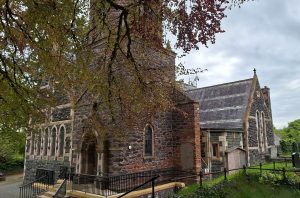 Hugh Montgomery (1743-1832) of Glenarm and Benvarden, Co. Antrim was one of the original founders or partners of the private bank, ‘H Montgomery & Company’ that was formed in Belfast in 1809. Around 1815 it became known as Northern Bank. He retired as a partner in 1822. His son, another Hugh Montgomery (1794-1867) succeeded his father in the partnership.
Hugh Montgomery (1743-1832) of Glenarm and Benvarden, Co. Antrim was one of the original founders or partners of the private bank, ‘H Montgomery & Company’ that was formed in Belfast in 1809. Around 1815 it became known as Northern Bank. He retired as a partner in 1822. His son, another Hugh Montgomery (1794-1867) succeeded his father in the partnership.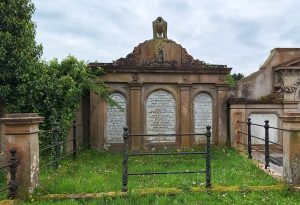 Hugh’s son, James C Montgomery was appointed as an additional Director in 1860. His health did not allow him to take up his duties and he resigned in 1862. He died abroad, in 1870 aged 34.
Hugh’s son, James C Montgomery was appointed as an additional Director in 1860. His health did not allow him to take up his duties and he resigned in 1862. He died abroad, in 1870 aged 34.
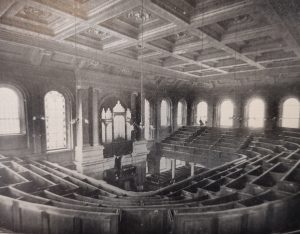 On Sunday 12th October 1919, the new War Memorial Organ in the church was used for the first time in public worship. In his address, Dr Park referred to the 555 men from the congregation and Sabbath School who had served in the Great war, 86 of whom had made the supreme sacrifice. The following Sunday, Mrs John Sinclair unveiled a brass tablet which had been erected by the afternoon Sabbath School in memory of the members of the congregation and school who fell in the Great War. The newspaper article on the unveiling reported that the tablet was attached to the front of the pulpit and recorded the names of the 86 fatalities. The church was not rebuilt and the congregation amalgamated with Ekenhead Memorial Presbyterian Church at its new site on the North Circular Road, adopting the name Rosemary Presbyterian Church. A history of the congregation by J W Kernahan includes a photograph of the War Memorial Organ, and the plaque on the front of the pulpit is visible.
On Sunday 12th October 1919, the new War Memorial Organ in the church was used for the first time in public worship. In his address, Dr Park referred to the 555 men from the congregation and Sabbath School who had served in the Great war, 86 of whom had made the supreme sacrifice. The following Sunday, Mrs John Sinclair unveiled a brass tablet which had been erected by the afternoon Sabbath School in memory of the members of the congregation and school who fell in the Great War. The newspaper article on the unveiling reported that the tablet was attached to the front of the pulpit and recorded the names of the 86 fatalities. The church was not rebuilt and the congregation amalgamated with Ekenhead Memorial Presbyterian Church at its new site on the North Circular Road, adopting the name Rosemary Presbyterian Church. A history of the congregation by J W Kernahan includes a photograph of the War Memorial Organ, and the plaque on the front of the pulpit is visible. 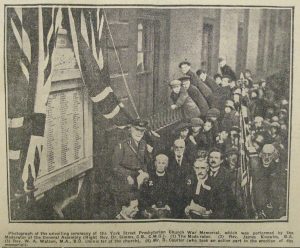 On Sunday 25th April 1920, two memorials were unveiled at the church by the Right Reverend Doctor John Morrow Simms, Moderator of the Presbyterian Church in Ireland, who had served as Senior Chaplain to the Ulster Division during the war. One of the mural tablets was erected inside the church and commemorated fourteen men from the congregation who died during the war. The second mural tablet was erected by 33rd Company Boy Scouts and was placed on external wall of the church at the junction of York Street and Earl Street. This memorial tablet recorded the names of 132 men from Earl Street and District who served in the Great War, 36 of whom paid the ultimate sacrifice. Newspaper articles about the unveilings recorded the names of those commemorated on the two tablets, although none of the fatalities named on the congregational tablet are named on the district tablet. In essence, the external tablet probably represented service and sacrifice by people who lived in the streets between Gallaher’s Tobacco factory and the York Street Flax Spinning mill. To the best of my knowledge, no photographs of either memorial tablet have survived, although there is a newspaper photograph of the unveiling of the district memorial. The church was not rebuilt, and the congregation merged with Castleton Presbyterian Church on York Road, the amalgamated congregation adopting the name of Alexandra Presbyterian Church.
On Sunday 25th April 1920, two memorials were unveiled at the church by the Right Reverend Doctor John Morrow Simms, Moderator of the Presbyterian Church in Ireland, who had served as Senior Chaplain to the Ulster Division during the war. One of the mural tablets was erected inside the church and commemorated fourteen men from the congregation who died during the war. The second mural tablet was erected by 33rd Company Boy Scouts and was placed on external wall of the church at the junction of York Street and Earl Street. This memorial tablet recorded the names of 132 men from Earl Street and District who served in the Great War, 36 of whom paid the ultimate sacrifice. Newspaper articles about the unveilings recorded the names of those commemorated on the two tablets, although none of the fatalities named on the congregational tablet are named on the district tablet. In essence, the external tablet probably represented service and sacrifice by people who lived in the streets between Gallaher’s Tobacco factory and the York Street Flax Spinning mill. To the best of my knowledge, no photographs of either memorial tablet have survived, although there is a newspaper photograph of the unveiling of the district memorial. The church was not rebuilt, and the congregation merged with Castleton Presbyterian Church on York Road, the amalgamated congregation adopting the name of Alexandra Presbyterian Church.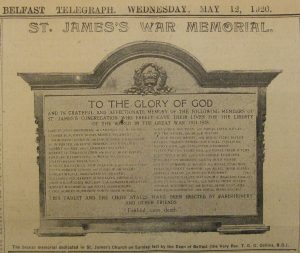 On 9th May 1920, the Very Reverend Thomas Gibson George Collins, Dean of Belfast dedicated memorials commemorating the service and sacrifice by men from the parish. Choir stalls and a bronze mural tablet, on which the names of thirty fatalities were recorded, was erected by congregational subscription. Mr Andrew Alexander Clendinning, a linen merchant, gifted the Roll of Honour tablet which recorded the names of 156 men who served and survived. Mrs Mary Kathleen Watson gifted a prayer desk in memory of her husband, the Reverend John Edmund Malone Watson MC, who was a chaplain to the forces and died of wounds on 10th April 1918, aged 31. In the 1943 Belfast Street Directory, the site was recorded as “Vacant” and the church was restored by 1947.
On 9th May 1920, the Very Reverend Thomas Gibson George Collins, Dean of Belfast dedicated memorials commemorating the service and sacrifice by men from the parish. Choir stalls and a bronze mural tablet, on which the names of thirty fatalities were recorded, was erected by congregational subscription. Mr Andrew Alexander Clendinning, a linen merchant, gifted the Roll of Honour tablet which recorded the names of 156 men who served and survived. Mrs Mary Kathleen Watson gifted a prayer desk in memory of her husband, the Reverend John Edmund Malone Watson MC, who was a chaplain to the forces and died of wounds on 10th April 1918, aged 31. In the 1943 Belfast Street Directory, the site was recorded as “Vacant” and the church was restored by 1947.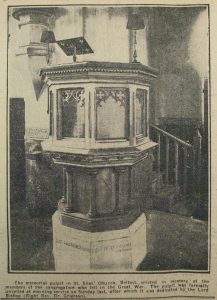 This church was located on the corner of Oldpark Road and Ardoyne Avenue and was built in 1901. On Sunday 30th May 1920, the Right Reverend Doctor Charles Thornton Primrose Grierson (Bishop of Down, Connor and Dromore) dedicated a new pulpit in the church as a memorial to those from the parish who had died in the Great War. The pulpit of white oak was manufactured by Purdy and Millard of Howard Street and a brass plate on the front panel named thirty fatalities, under the headings Navy and Army. On the base of the pulpit were carved the words of His Majesty King George V, “The men of Ulster have proved how nobly they fight and die.” The memorial was unveiled by Mr James Barlowe and Mr James Bustard, two former churchwardens who had both lost their only sons in the war. In his address, the Lord Bishop stated that 160 men from the church had volunteered for service in the Great War. The memorial cost £150, which equates to approximately £5,500 in current terms. Newspaper reports on the unveiling ceremony recorded the names of the fatalities and a photograph of the memorial pulpit was published in the Belfast Telegraph. The 1951 and 1955 street directories record that the site for the replacement church was located at the junction of Cliftonville Road and Cardigan Drive, and the new church was completed in 1958.
This church was located on the corner of Oldpark Road and Ardoyne Avenue and was built in 1901. On Sunday 30th May 1920, the Right Reverend Doctor Charles Thornton Primrose Grierson (Bishop of Down, Connor and Dromore) dedicated a new pulpit in the church as a memorial to those from the parish who had died in the Great War. The pulpit of white oak was manufactured by Purdy and Millard of Howard Street and a brass plate on the front panel named thirty fatalities, under the headings Navy and Army. On the base of the pulpit were carved the words of His Majesty King George V, “The men of Ulster have proved how nobly they fight and die.” The memorial was unveiled by Mr James Barlowe and Mr James Bustard, two former churchwardens who had both lost their only sons in the war. In his address, the Lord Bishop stated that 160 men from the church had volunteered for service in the Great War. The memorial cost £150, which equates to approximately £5,500 in current terms. Newspaper reports on the unveiling ceremony recorded the names of the fatalities and a photograph of the memorial pulpit was published in the Belfast Telegraph. The 1951 and 1955 street directories record that the site for the replacement church was located at the junction of Cliftonville Road and Cardigan Drive, and the new church was completed in 1958.
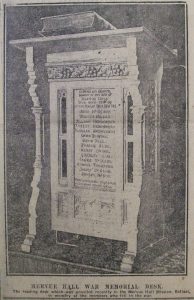 On Sunday 19th September 1920 a reading desk was dedicated as a memorial in this mission hall, which was associated with Donegall Street Congregational Church. The desk was unveiled by Captain William Reid and the names of fourteen fatalities from the congregation are recorded on the front of the desk. The newspaper coverage of the unveiling service included a photograph of the memorial and the hall had been re-opened by 1945.
On Sunday 19th September 1920 a reading desk was dedicated as a memorial in this mission hall, which was associated with Donegall Street Congregational Church. The desk was unveiled by Captain William Reid and the names of fourteen fatalities from the congregation are recorded on the front of the desk. The newspaper coverage of the unveiling service included a photograph of the memorial and the hall had been re-opened by 1945.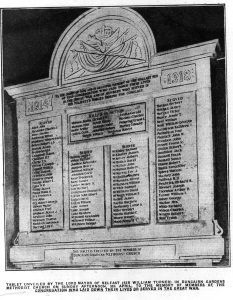 On 7th April 1925, Sir William Turner JP, Lord Mayor of Belfast, unveiled a polished marble tablet which recorded and the names of the fourteen members of the congregation who died and the names of a further 100 people who served in the Great War. The memorial was the work of Thompson & Sons of Limestone Road and the embellishment at the top of the tablet features crossed flag and the Dove of Peace under a Crown. A photograph of the memorial was published in the Belfast Telegraph in April 1925 and a fine photograph of the memorial can be found online. The church was never rebuilt, and the congregation merged with Carlisle Memorial Methodist Church.
On 7th April 1925, Sir William Turner JP, Lord Mayor of Belfast, unveiled a polished marble tablet which recorded and the names of the fourteen members of the congregation who died and the names of a further 100 people who served in the Great War. The memorial was the work of Thompson & Sons of Limestone Road and the embellishment at the top of the tablet features crossed flag and the Dove of Peace under a Crown. A photograph of the memorial was published in the Belfast Telegraph in April 1925 and a fine photograph of the memorial can be found online. The church was never rebuilt, and the congregation merged with Carlisle Memorial Methodist Church. 
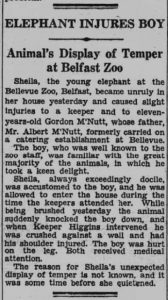 After the German air raid on the night of 15th/16th April 1941, Antrim Road residents raised concerns that dangerous animals might escape during air raids. The account in Scott Edgar’s
After the German air raid on the night of 15th/16th April 1941, Antrim Road residents raised concerns that dangerous animals might escape during air raids. The account in Scott Edgar’s 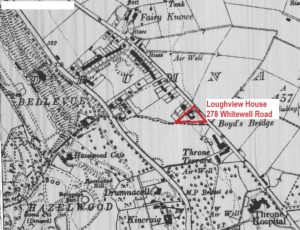
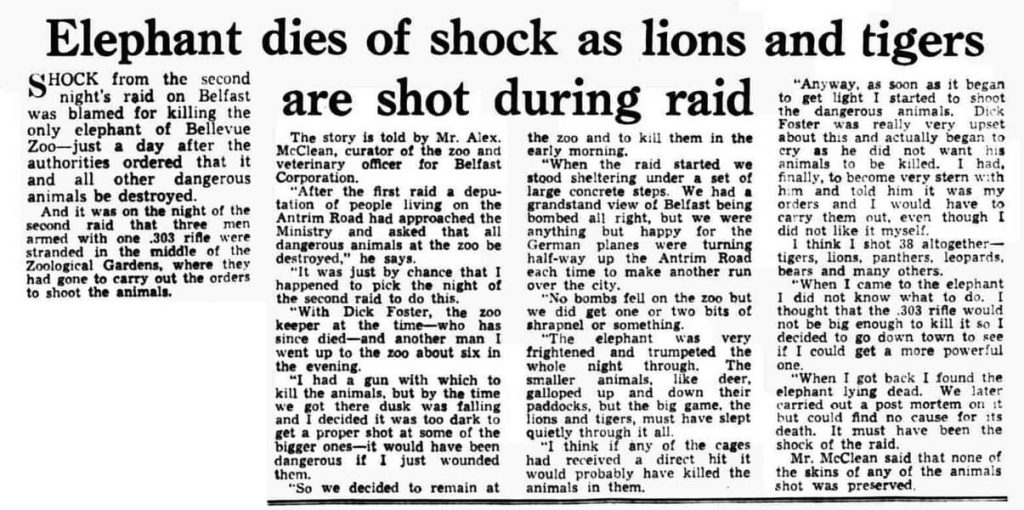
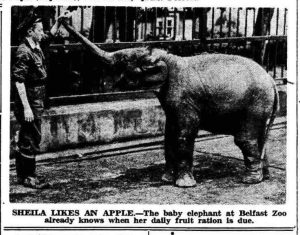
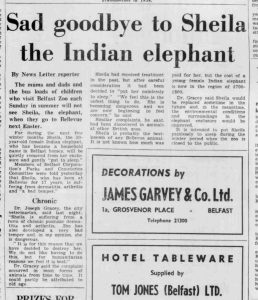 In essence, when articles were compiled this century, the researchers knew there was an elephant called Sheila at the zoo in 1938 and that an elephant called Sheila died at the zoo in 1965. Unfortunately, they made the assumption that the elephant that died in 1965 was the elephant who had arrived in 1938.
In essence, when articles were compiled this century, the researchers knew there was an elephant called Sheila at the zoo in 1938 and that an elephant called Sheila died at the zoo in 1965. Unfortunately, they made the assumption that the elephant that died in 1965 was the elephant who had arrived in 1938.

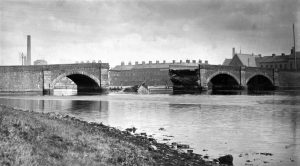
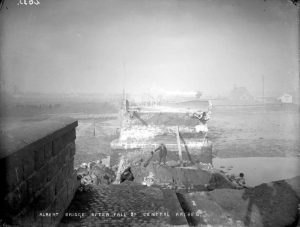
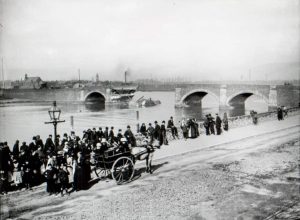 The
The 

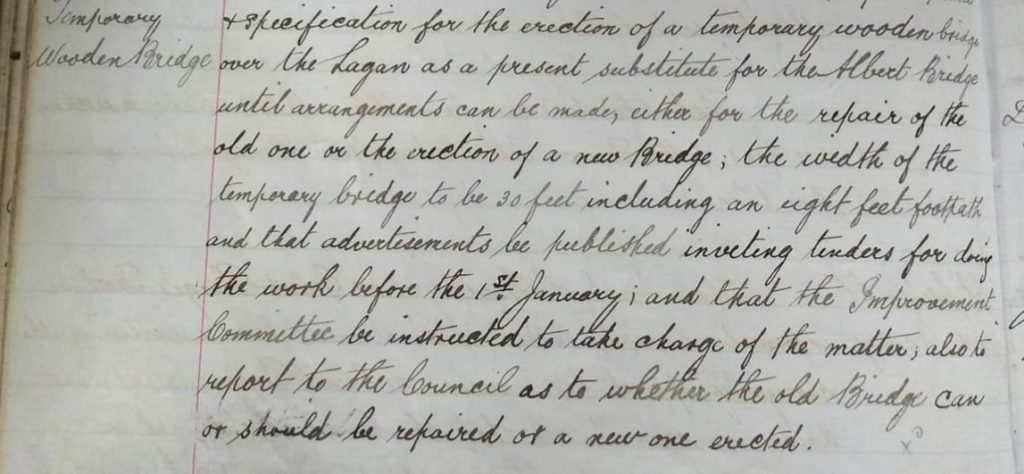 The
The 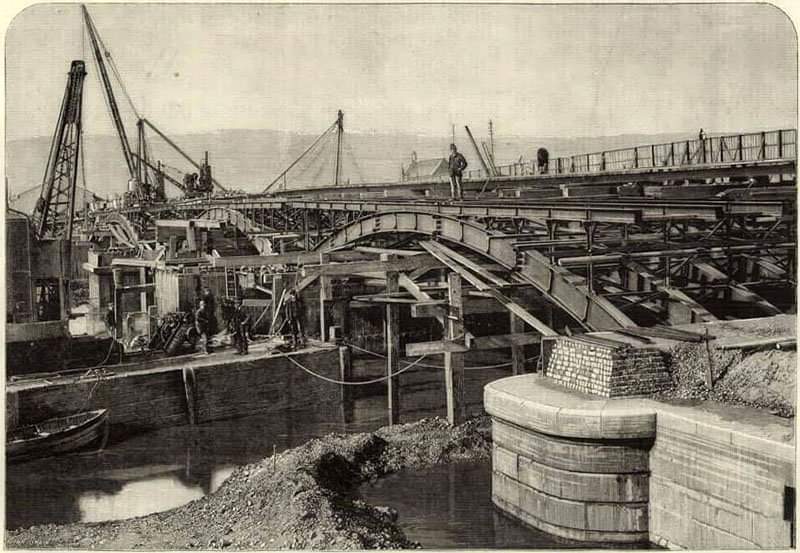
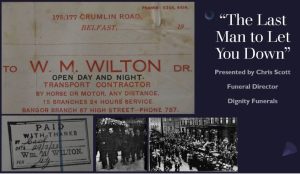
 Find out about the court case, in 1931, focusing around falsifying the age of a person during the death registration process. Hear all about the invention of a foghorn for a vault in 1932, specifically designed for those who feared premature burial! Chris will also talk about some of the funeral customs and superstitions from that era. “Never count the cars or people at a funeral” – Apparently it would bring you bad luck! The original Wilton Day books and other funeral related material will be available for inspection. Who knows – you might discover something to supplement your own family history research!
Find out about the court case, in 1931, focusing around falsifying the age of a person during the death registration process. Hear all about the invention of a foghorn for a vault in 1932, specifically designed for those who feared premature burial! Chris will also talk about some of the funeral customs and superstitions from that era. “Never count the cars or people at a funeral” – Apparently it would bring you bad luck! The original Wilton Day books and other funeral related material will be available for inspection. Who knows – you might discover something to supplement your own family history research! A colony of forty cottages, known collectively as St Quentin Park after the 1918 battle, was built in two phases in 1922 and 1923 on 10.5 acres of land purchased from Thomas Alexander Archbold of Hillview and Captain Robert Humphrey Bland of Tobarcooran for £1503-6-6, which equates to approximately 68,380 in current terms. Mr Archbold’s daughter, Jane Russell Archbold, had served with the Voluntary Aid Detachment as a Staff Nurse at the UVF Hospital in Belfast from January 1916 to February 1919. Captain Bland had served with the Royal Irish Rifles and the Labour Corps in the Great War. There were three cottage types in the colony with 38 semi-detached cottages and two detached cottages.
A colony of forty cottages, known collectively as St Quentin Park after the 1918 battle, was built in two phases in 1922 and 1923 on 10.5 acres of land purchased from Thomas Alexander Archbold of Hillview and Captain Robert Humphrey Bland of Tobarcooran for £1503-6-6, which equates to approximately 68,380 in current terms. Mr Archbold’s daughter, Jane Russell Archbold, had served with the Voluntary Aid Detachment as a Staff Nurse at the UVF Hospital in Belfast from January 1916 to February 1919. Captain Bland had served with the Royal Irish Rifles and the Labour Corps in the Great War. There were three cottage types in the colony with 38 semi-detached cottages and two detached cottages. 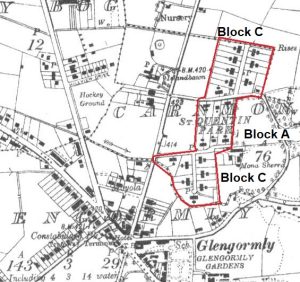 Work commenced in August 1921 and the ten cottages at Block A were completed in September 1922. The fourteen cottages at Block C were completed in January 1923 and the sixteen cottages at Block B were completed on 11th May 1923. The average size of each plot was 0.26 acres which provided a sizeable area in which the veterans could grow fruit and vegetable and the initial rent was five shillings per week (approximately £11pw in current terms). The cottages did not have a water supply and four pumps supplied water to forty households. The first record of occupants of the cottages appears in the 1924.
Work commenced in August 1921 and the ten cottages at Block A were completed in September 1922. The fourteen cottages at Block C were completed in January 1923 and the sixteen cottages at Block B were completed on 11th May 1923. The average size of each plot was 0.26 acres which provided a sizeable area in which the veterans could grow fruit and vegetable and the initial rent was five shillings per week (approximately £11pw in current terms). The cottages did not have a water supply and four pumps supplied water to forty households. The first record of occupants of the cottages appears in the 1924. 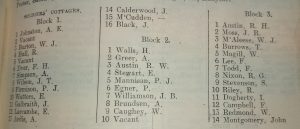 Isaac Doherty was born on 5th July 1877 at Ballyfinaghy to Robert Doherty and Anne Doherty (nee McGowan) and he married Mary Graham of Drew Street on 5th September 1912 at St Anne’s Parish Church. Isaac enlisted with the Royal Inniskilling Fusiliers and was posted to France with the Ulster Division in October 1915. He was serving with the Royal Engineers when he was transferred to the Class Z Army Reserve on 8th May 1919. In 1928, Mary’s daughter from her first marriage, Lily Graham, died at the Royal Victoria Hospital at the age of 21. Isaac Doherty was living at 909 Crumlin Road when he died on 24th February 1940, aged 63, and Mary Doherty died on 7th May 1957, aged 80. Isaac and Mary Doherty and Lily Graham are buried in Dundonald Cemetery.
Isaac Doherty was born on 5th July 1877 at Ballyfinaghy to Robert Doherty and Anne Doherty (nee McGowan) and he married Mary Graham of Drew Street on 5th September 1912 at St Anne’s Parish Church. Isaac enlisted with the Royal Inniskilling Fusiliers and was posted to France with the Ulster Division in October 1915. He was serving with the Royal Engineers when he was transferred to the Class Z Army Reserve on 8th May 1919. In 1928, Mary’s daughter from her first marriage, Lily Graham, died at the Royal Victoria Hospital at the age of 21. Isaac Doherty was living at 909 Crumlin Road when he died on 24th February 1940, aged 63, and Mary Doherty died on 7th May 1957, aged 80. Isaac and Mary Doherty and Lily Graham are buried in Dundonald Cemetery.  The Commonwealth War Graves Commission (CWGC) website includes a Civilian War Dead section which lists the place of death and the place of residence for fatalities, the information having been collated from the Civil Defence Authority fatality lists and other sources. The anomalies between the figures specified on the Belfast City Council plaques and the CWGC Civilian War Dead List (henceforth CWGC List) will be examined in this article.
The Commonwealth War Graves Commission (CWGC) website includes a Civilian War Dead section which lists the place of death and the place of residence for fatalities, the information having been collated from the Civil Defence Authority fatality lists and other sources. The anomalies between the figures specified on the Belfast City Council plaques and the CWGC Civilian War Dead List (henceforth CWGC List) will be examined in this article. 1 Temporary Mortuaries
1 Temporary Mortuaries
 Campbell College was taken over by the military authorities as the 24th (London) General Hospital shortly after the start of the Second World War and was hit on the night of 4th/5th May 1941. The Blitz Victims List compiled by the Northern Ireland War Memorial records that 24 people died at the hospital, including one civilian fatality. Of the 23 army personnel killed, nine are buried in Northern Ireland and the remainder were repatriated to Great Britain for interment. The civilian was Mary Jane Close (58) who was injured at her home in Westbourne Street and died at the hospital and is buried in Dundonald Cemetery.
Campbell College was taken over by the military authorities as the 24th (London) General Hospital shortly after the start of the Second World War and was hit on the night of 4th/5th May 1941. The Blitz Victims List compiled by the Northern Ireland War Memorial records that 24 people died at the hospital, including one civilian fatality. Of the 23 army personnel killed, nine are buried in Northern Ireland and the remainder were repatriated to Great Britain for interment. The civilian was Mary Jane Close (58) who was injured at her home in Westbourne Street and died at the hospital and is buried in Dundonald Cemetery.
 4 Mountpottinger – Thorndyke Street
4 Mountpottinger – Thorndyke Street 5 Sandy Row – Blythe Street
5 Sandy Row – Blythe Street
 7 Tiger’s Bay – Hogarth Street
7 Tiger’s Bay – Hogarth Street

 10 Donegall Street – St Patrick’s Church
10 Donegall Street – St Patrick’s Church 11 Carrick Hill – Unity Street and Trinity Street
11 Carrick Hill – Unity Street and Trinity Street


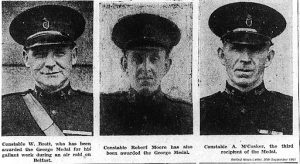
 During an air raid in May, Auxiliary Nurse Denise Forster (21) was on duty at the Ambulance Depot on the Holywood Road when it was demolished by a high explosive bomb.
During an air raid in May, Auxiliary Nurse Denise Forster (21) was on duty at the Ambulance Depot on the Holywood Road when it was demolished by a high explosive bomb. 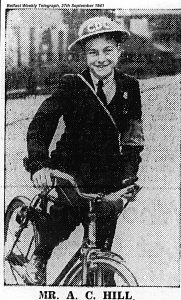 Messenger Alexander Cecil Hill (17), an office assistant from Convention Street, received the BEM. Although severely shaken by an explosion nearby, Alexander directed traffic at a main road whilst bombs were falling nearby. Later, whilst delivering an urgent message to the Report Centre, he was blown off his bicycle by explosions twice but each time he remounted and delivered the message.
Messenger Alexander Cecil Hill (17), an office assistant from Convention Street, received the BEM. Although severely shaken by an explosion nearby, Alexander directed traffic at a main road whilst bombs were falling nearby. Later, whilst delivering an urgent message to the Report Centre, he was blown off his bicycle by explosions twice but each time he remounted and delivered the message.  BEMs were awarded to Bomb Identification Officer William John Ford (51) and Messenger William Ernest Bennett (15) of Wandsworth Gardens for rescue work at Cliftonville Road where bombs had destroyed a number of houses and fractured a gas main. Ford and Bennett burrowed six yards through rubble to bring an elderly man to safety and then they rescued two stranded women from a house that was in danger of collapse. Bombs were falling as they worked and both suffered from the effects of inhaling coal gas. William Bennet later joined the National Fire Service.
BEMs were awarded to Bomb Identification Officer William John Ford (51) and Messenger William Ernest Bennett (15) of Wandsworth Gardens for rescue work at Cliftonville Road where bombs had destroyed a number of houses and fractured a gas main. Ford and Bennett burrowed six yards through rubble to bring an elderly man to safety and then they rescued two stranded women from a house that was in danger of collapse. Bombs were falling as they worked and both suffered from the effects of inhaling coal gas. William Bennet later joined the National Fire Service.